Tile "hog" on the kitchen apron: examples of design and subtleties of laying

Now on the shelves of building supermarkets you can find a lot of materials for finishing a working apron in the kitchen. Among this list, tiles are still popular.
This product has many variations, where the "hog" tile is considered a rather interesting, practical and ultramodern idea, which is a European option for finishing and surface decoration, which is also in demand in Russia.
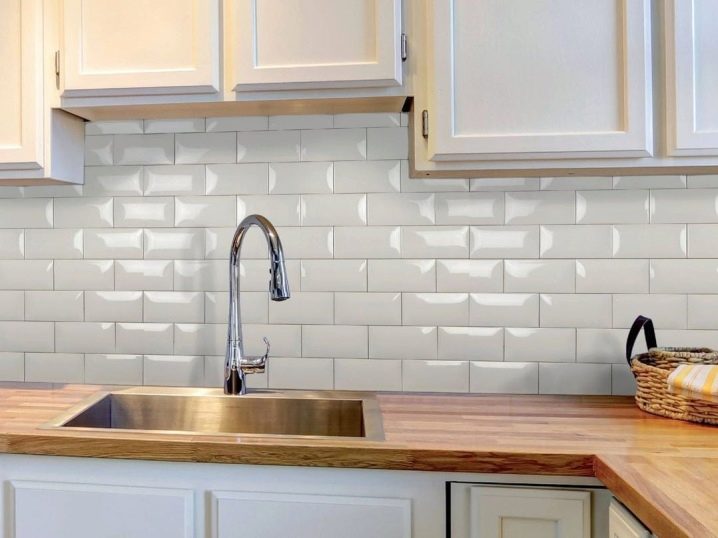
What it is?
Fashion trends, according to which a few decades ago the kitchen in living quarters was completely tiled with plain light tiles, have sunk into oblivion. However, the working area, which is called the "apron", is still decorated and tiled, since this solution stands out primarily for its practicality.
Ceramics are notable for their visual appeal and durability., and modern manufacturers offer a wide range of similar facing materials. Among the available variety, the tile "hog", which has a second name - "metro", stands out for the increased demand.
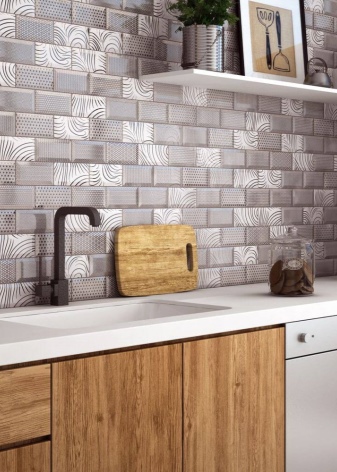
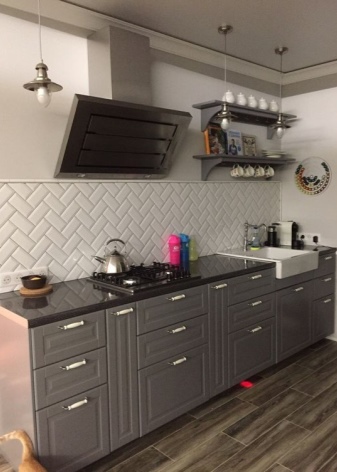
This product for installation on walls and other surfaces indoors and outdoors looks like bricks. Thanks to this feature, the work area in the kitchen can be distinguished in the overall design of the room. In addition, some solutions suggest using tiles also for decorating window or doorways to concisely complete the design idea.
Small-format products have a glazed glossy surface; matte varieties and mirror elements are also on sale. In addition, exclusive products are available with aging effects on cladding elements. The design characteristics of the "hog" include a slightly beveled edge along the perimeter of each part, this feature allows the tiles to acquire texture and volume on the wall surface.
Today, manufacturers also offer options with a minimum set of chamfers or without them at all.
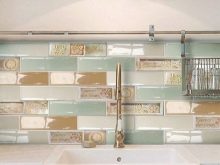

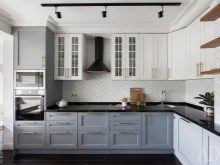
The size range of products is distinguished by the fact that the length of the elements will always exceed the width by several times. The following models are most in demand:
- 7.5x30 cm;
- 10x20 cm;
- 15x30 cm.
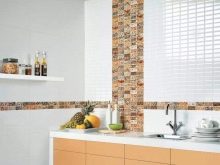
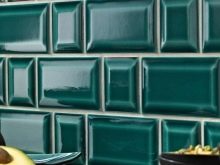

Also, in some collections there are elements of non-standard sizes, which are most often used as a bright accent in the entire ceramic composition on the wall.
Among the characteristics of the tile, the following properties should be highlighted:
- the material does not let dirt inside;
- the working area lined with such tiles does not require special care products;
- product manufacturers offer the widest assortment of "hog" tiles, due to which the products will fit into any design and interior of the room;
- facing elements are distinguished by their resistance to various temperature fluctuations, in addition, the tiles do not collapse from an increased level of humidity;
- such an apron in the kitchen can last a long time;
- the principle of laying the elements does not require special qualifications from the master.
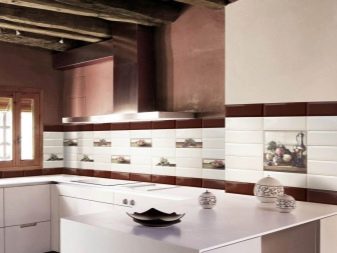
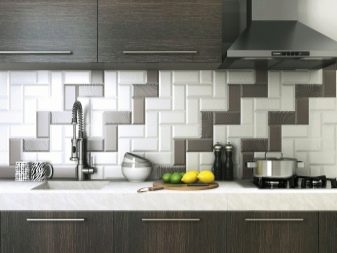
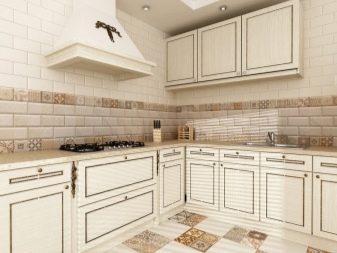
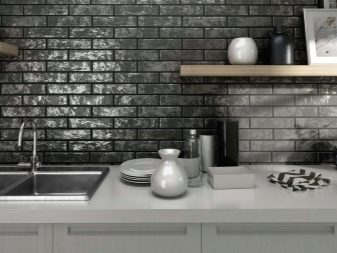
Layout options
The "hog" tile is notable for its versatility, which concerns the availability of different options for laying elements on the wall surface. Today there are six ways to place items.
Horizontal layout
Due to the appearance of brick-like elements, such an idea for surface decoration is most in demand. Some masters design an apron with an offset of elements or a razorbashny.
As a rule, such an option can be performed even by beginners, however, the main requirement for laying is strict adherence to the horizontal line in the course of fixing the products to the wall.
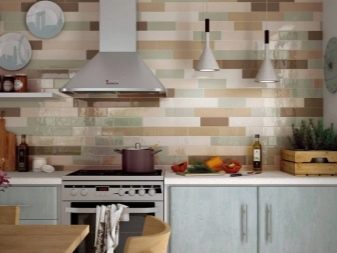
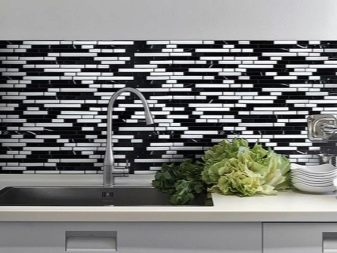
Stacking method
This method is most often used for materials of different colors. As a rule, elements of contrasting shades act in this role. In this case, the main focus is on the seams between the elements.

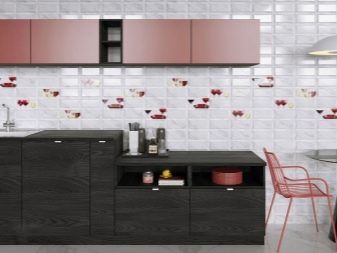
Zigzag fastening
A bold solution for the interior, where the emphasis will be on the work area. Choosing a similar tile idea, the components can be positioned at an angle of 90 or 45 degrees.
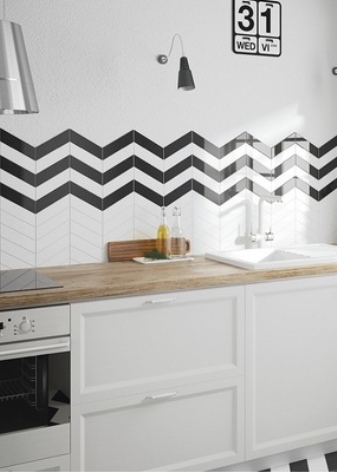
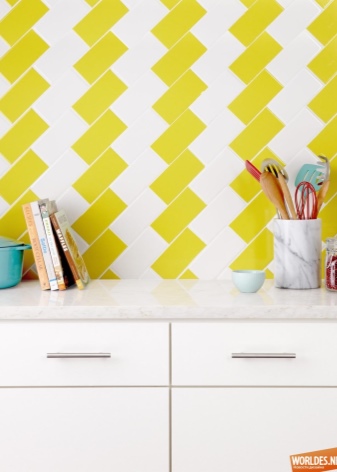
Diagonal arrangement
With this method of laying the "hog", you can visually increase the area of the kitchen. In addition, the volumetric elements laid out diagonally will be a bright accent in the interior, even when using pastel colors.
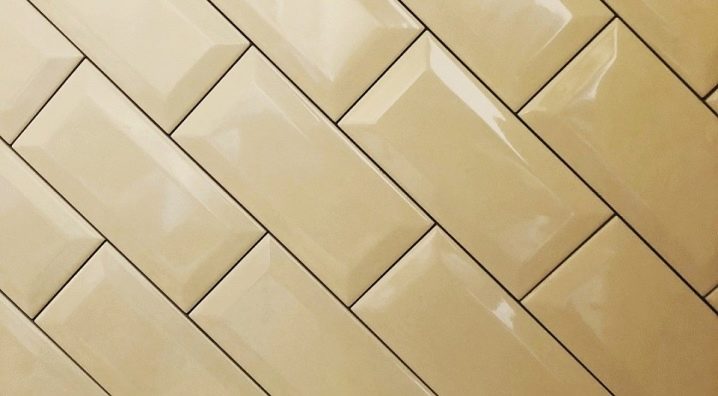
Vertical mount with offset elements
The implementation of such an idea will require some skill from the master, but the result will exceed all expectations. Experts recommend choosing a similar solution for kitchens that are not constrained in their area.
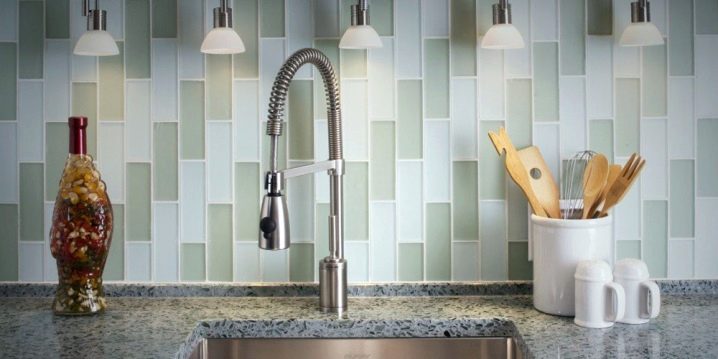
Vertical stack
Another extraordinary solution for decorating a kitchen apron with "hog" tiles. In this option, you should focus on well-designed tile joints.
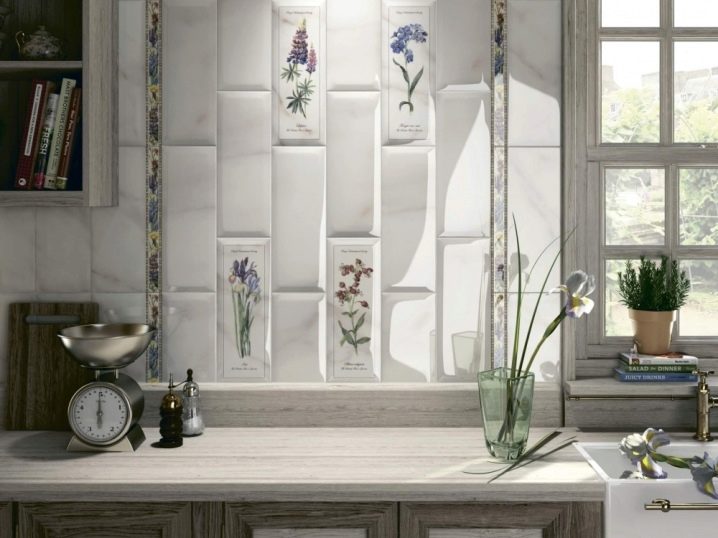
What styles is it suitable for?
Among the newfangled trends in the design of kitchens, the tiles in question are used in refined Provence, classic modern. In addition, designers recommend laying out an apron when decorating a room in a loft or industrial style. In the course of selecting the size and type of elements, the color scheme in which the furniture is decorated is taken into account.
Classic beige or white tiles will be appropriate in any direction of room design. For the Scandinavian direction "hog" is usually combined with walls covered with wallpaper. As for modern hi-tech minimalism, they try to combine the shades of the facing elements with the basic ones in this direction - chrome and steel. Art Deco involves the use of calm or contrasting color schemes, most often the "pig" is laid out by analogy with a black and white chessboard.
Simple rural solutions, for example, country or Provence, suggest the presence of green or yellow, it can also be blue or pink shades with highlighted elements of vegetation.
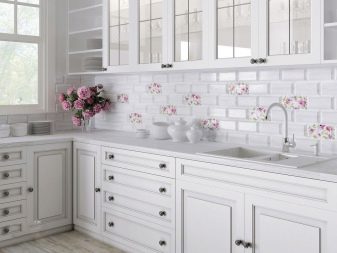
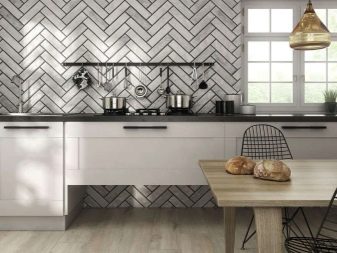
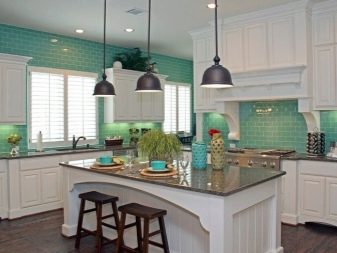
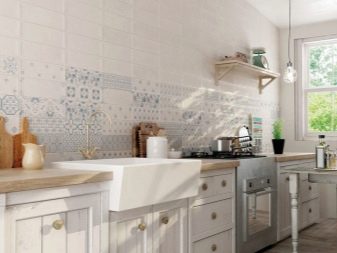
How to choose?
Having decided on the style solution for the design of the kitchen, it is worth choosing the right tiles for laying on the wall. Material manufacturers, as well as repair specialists, suggest following important recommendations when purchasing.
- It will be more correct to purchase facing products with a margin, it is better to take more by 5-10% of the total volume. Such a precaution is associated with the fact that some part of the installation process may be damaged.
- The size of the elements should be selected taking into account the size of the working area and the kitchen itself.
- Not always the most expensive type of "hog" will be of the highest quality. Most often, the buyer overpays for the brand, while the quality of the material may not be the best.
- If it is supposed to create some kind of composition from elements, then it is worth considering that this material will be used in the kitchen for more than one year, so the chosen project may not correspond to the new design of the room in the future. The optimal solution would be the selection of material in soothing shades that will be appropriate in any style and interior.
- It is best to buy the entire amount of material in one place so that there are no situations when elements of the same series will differ in color.
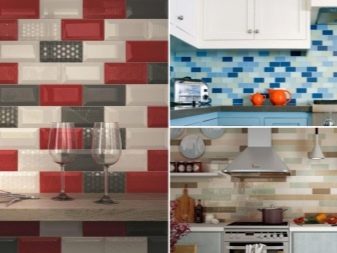
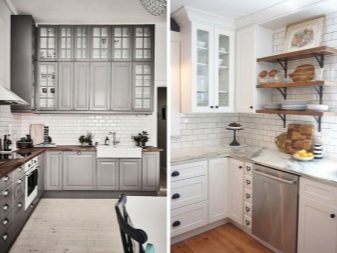
Installation recommendations
An apron laid out with a "hog" will look beautiful and laconic only if it is properly styled. In order to properly tile the wall, it is recommended to adhere to a number of nuances in the work.
- The nuance that decides everything is an even and high-quality seam between the elements. It is these works that will require maximum accuracy in the course of carrying out, regardless of the type of installation chosen.
- To extend the life of a kitchen apron, it is worthwhile to properly prepare the wall for cladding. It is important that its surface is perfectly flat, so preliminary preparation, as a rule, will require a primer, putty, etc.
- It is worth considering the peculiarity of the volumetric tile, in the light of which it will take several times more glue to fix it than in the case of ordinary even material.
Well-oiled elements will have a good level of adhesion to the wall surface, which will prevent material from moving away from the surface.

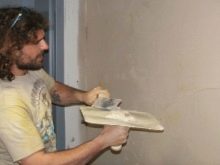
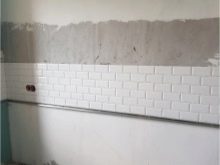
- The recommended joint thickness for this material is 2–5 mm.
- Experts recommend sawing the ends of the elements at an angle of 45 degrees in the corners of the working area. Thus, the finished finish will look much neater. Also for this purpose, plastic corners are used.
- For those cases when the apron will not act as a bright accent in the interior of the kitchen, it is better to decorate the seams with putty to match the material. And vice versa, in order to highlight this area, you can resort to the contrasting design of the inter-tile space. It is more correct to select a moisture-resistant grout.
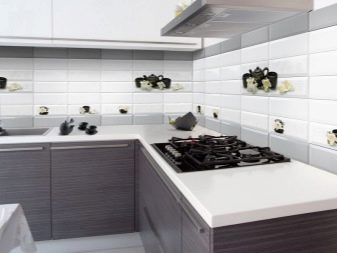
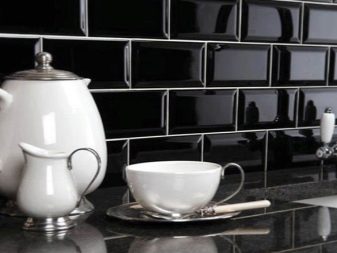
How to choose a skirting board for an apron?
In some cases, special plastic skirting boards are used to seal the joints between furniture and the wall. These elements perform a rather important function - they ensure the tightness of the joint. As a rule, such a detail can be not only from the bottom of the apron, but also from the top.
The plinth is selected to match the tile; to highlight the borders, you can purchase a detail in a contrasting color that will emphasize the shape and texture of the apron.
In order for the connecting piece to adhere to the wall as much as possible, it should be fixed on the lower or upper part of the facet of the elements.

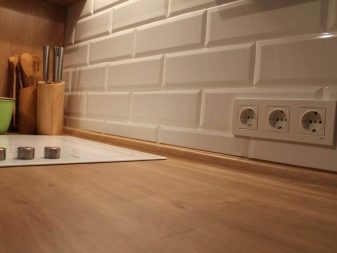
Interesting examples in the interior
For bold and original solutions in the design of the kitchen, the facing of the apron in black and white colors with elements in dimensional asymmetry under the stone will become relevant. Clear and regular lines of glossy details will harmonize perfectly in the contrast of light and dark, and due to the differences in size, the severity of the basic shades will have an original appearance that will highlight this accent on the kitchen wall.
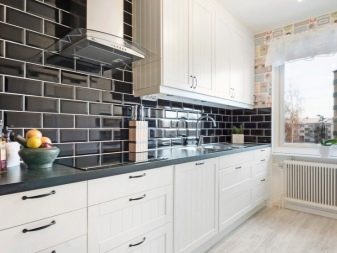
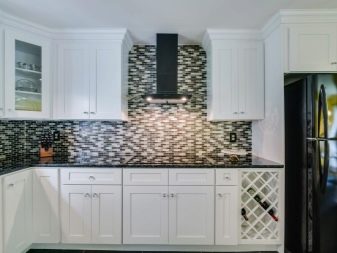
For kitchens where there is only one or two colors in the interior and color design of furniture, you can use a bright and colorful accent from a tiled texture in a combination of red and base colors. Complement the idea of highlighting in the center of several details with photo printing.


To transform the working area with the "hog" tiles, it will be enough to use a non-standard method of laying the elements. The herringbone option will help to make the styling original and memorable even when using white. A warm yellow accent made from bricks of the same size will add brightness and juiciness.
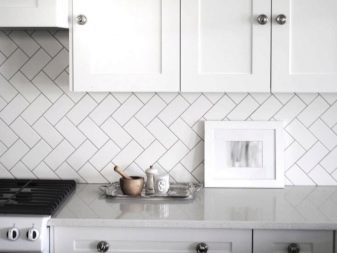
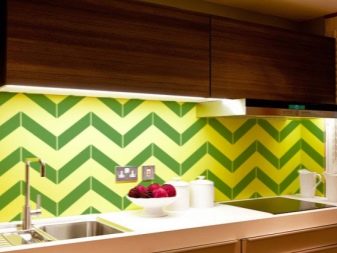
For tips from experts on laying an apron in the kitchen, see the video below.













The comment was sent successfully.